My race and ethnicity class is discussing American Indian team mascots today, so I thought I’d put up some images of a few. There are many, many more than what I have here (think of every high school with teams called the Redskins), but these are some of the most often discussed.
This is the logo (found here) of the University of Illinois’s sports teams, the Fighting Illini, named after the Illini tribe (really a confederation of tribes such as the Peoria) originally inhabiting the area:
Each year a student is chosen to represent Chief Illini at sports events. The student wears what is described as “traditional” Indian clothing and until recently performed dance routines that have nothing whatsoever in common with anything I’ve ever seen at a powwow. Here is a student dressed up as Chief Illini (found here):
I found this video on youtube of Chief Illini’s “last dance,” meaning his last performance at an official NCAA-sponsored sporting event:
Last I heard the University of Illinois bowed to decades of pressure and has retired the embodiment of the mascot. They apparently no longer have a Chief Illini (a man who dresses up like an American Indian and jumps around), but they have retained the “Fighting Illini” language.
UPDATE: Not so fast. Resist Racism has a great summary of how the University is keeping Chief Illini around even after retiring him.
The University of North Dakota’s mascot is the Fighting Sioux (found here):
Florida State’s teams are the Seminoles; here is a student representing the team at a game (found here):
Here is the Florida State NCAA logo (found here):
This is the original Chief Wahoo, the mascot for the Cleveland Indians (found at Wikipedia). According to Wikipedia, it was used from 1946 to about 1950.
Here is the updated Chief Wahoo (found here):
A quote from the Wikipedia entry on Chief Wahoo:
According to polling results published in Sports Illustrated, “Although most Native American activists and tribal leaders consider Indian team names and mascots offensive, neither Native Americans in general nor a cross section of U.S. sports fans agree.”[9] According to the article, “There is a near total disconnect between Indian activists and the Native American population on this issue.”[9]However, the results of the poll have been criticized due to Sport’s Illustrated’s refusal to provide polling information (i.e. how participants were recruited and contacted, if they were concentrated in one region, if one ethnic group is over represented and the exact wording and order of questions).[10]
Here is a link to an article by King et al. discussing both the discourse in and the methodology of the Sports Illustrated article (in the March 4, 2002 issue).
Here is a website with lots of cartoons related to the issue of American Indian mascots, and the documentary “In Whose Honor?” looks at the protests surrounding Chief Illini.
The February 2004 issue of Journal of Sport & Social Issues (vol. 28 issue 1) has several very good articles about American Indian mascots that I’ve used in both race and sport classes when we talk about the continued use of caricatures and other portrayals of American Indians and why they are viewed differently than, say, an old Mammie-type image of African Americans. We also always discuss discourses surrounding American Indian mascots, particularly the idea that they honor or respect American Indians, and the selective use of certain American Indian voices to invalidate critiques of Indian mascots. Who gets to be Indian for the purposes of speaking about whether or not Indians resent the mascots? Why do non-Indians feel a special attachment to, and often identify with, these images? Does it really matter whether or not most American Indians personally oppose the mascots–is that the issue here?
The Sports Illustrated article could also be good for a discussion of methodology and the scientific method; the fact that the magazine would not release information on their methodology violates the very spirit of scientific inquiry (the ability to replicate others’ work to check its validity, as well as open sharing of information).
For other examples of the use of images of American Indians, see here and here.
This cartoon suggests that the idea that these mascots are a way of honoring American Indians is pretty absurd.
NEW! Brady P. sent in this image that questions why American Indian mascots are acceptable when most people would define the mascots that caricature other groups as patently offensive:
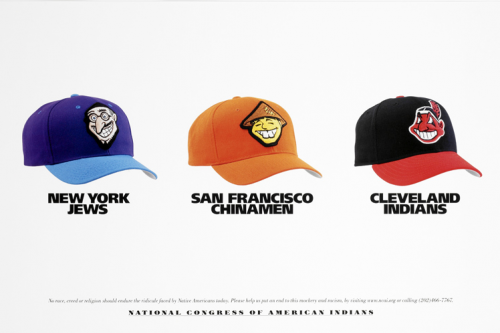
Of course, there is a Dutch soccer team called The Jews.
Gwen Sharp is an associate professor of sociology at Nevada State College. You can follow her on Twitter at @gwensharpnv.
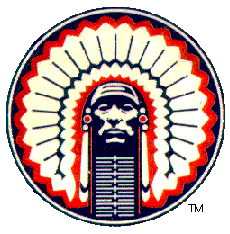
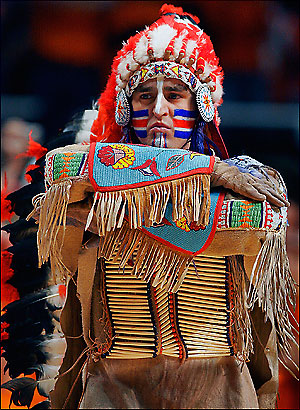
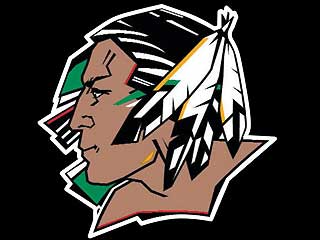
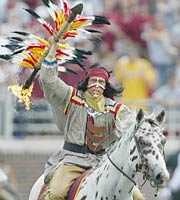

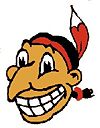
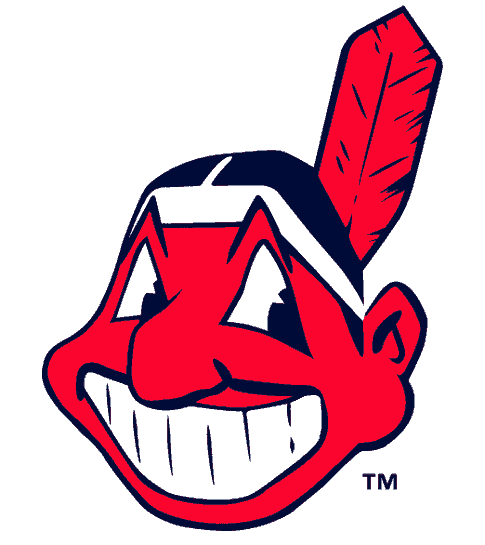
Comments 46
Bob — September 22, 2008
http://en.wikipedia.org/wiki/Fighting_Whites
This was an interesting response by a University of Northern Colorado intramural basketball team.
mordicai — September 22, 2008
Man, the worst part is, the baseball team before the Cleveland Indians was the SPIDERS. How awesome would The Spiders be?
OP Minded — September 23, 2008
They should just rename all the Native American mascots "The Fighting Pioneers" and be done with it.
Kirsten — September 23, 2008
I think it's pretty weird that a sports team would want to call itself "Fighting" anything. It sounds to me as though they're advertising that they play dirty, and equating sport with war or violence...
OP Minded — September 24, 2008
Weird to fight for a win?
Would you prefer they call themselves the "Cooperating Community Organizers"?
stylebutch — September 25, 2008
Apparently, the Seminole tribe of Florida actually has a close working relationship with the university including providing dancers for games and the like. Of course, not everyone in the tribe is cool with it.
On the other hand, the word Sioux is horribly offensive to a lot of native american people around the Dakotas, especially the Lakota/Dakota tribes with whom it is associated with in North Dakota. People in the area have been fighting the mascot since 1970, and as per a recent ruling the university will have to change its mascot in 2010 unless it can gain the support of the local Standing Rock tribe.
Kirsten — September 30, 2008
OP Minded: Well, no, but I still find the "fighting" thing weird.
Funny - I wouldn't have said that the whole "it matters not whether you won or lost, but how you played the game" ethos survived in Britain at all (much to our loss). But I think the average Brit would find it repellent for a team to be called "fighting something". Maybe it's just a difference in what we're accustomed to.
Sociological Images » NOTRE DAME’S FIGHTING IRISH MASCOT — October 5, 2008
[...] couple of weeks ago I posted about American Indian sports mascots. An interesting comparison to spark discussion, and an example students often bring up, is the [...]
Sociological Images » ANACHRONISM AND AMERICAN INDIANS — November 29, 2008
[...] with feathers, buckskins, and moccasins. These anachronisms are everywhere (see, for example, here, here, here, here, and [...]
Rob Schmidt — December 4, 2008
For more on the subjects you've raised here, see "Team Names and Mascots" (http://www.bluecorncomics.com/mascots.htm) and "The Sports Illustrated Poll on Mascots" (http://www.bluecorncomics.com/sipoll.htm).
Sociological Images » DUTCH SOCCER CLUB NICKNAMED “THE JEWS” — December 9, 2008
[...] mascots, particularly how it compares to American Indian mascots (for posts on that topic, see this post) and Notre Dame’s Fighting Irish mascot (see post here). Critics of American Indian mascots [...]
Anonymous — February 13, 2009
Being that i am Native American I don't think that native american mascots are offensive. I just think that the way people in the stands objectify the way native american mascots are is offensive. Like the tomahawk chop for instance i think that it is offensive. There can be native american mascots and not have any offensive motions.
INDIANa resident — March 7, 2009
This argument will always come down to what you want to see.....Good in something or Bad in something. I have witnessed this dance that occurs at the Illini football and basketball games. The Chief does not speak or act stupid I would not even consider him as a mascot, more of a symbol of something or someone honorable. He only participates in about 5 minutes of the halftime of a game. He does not stand on the sidelines and cheer or act goofy. When he performs the entire stadium stands and almost reverently watches his performace. The Chief is an 80 year old tradition. The statement made by the original post from Gwen that the Chief...."performed dance routines that have nothing whatsoever in common with anything I’ve ever seen at a powwow" and I am sure she has witnessed thousands, can be argued with "the rap music that I hear nowadays has nothing whatsoevers in common with anything that anyone 80 years ago would call music. I Think there is a great need for some thick skin in todays society. I don't hear a whole lot of noise when others are characatured or demeened in a sports venue. Why? Padres, Cowboys, Irish, Cornhuskers. Movies such as "White Men Cant Jump" or artist called "Cracker" are ok but a University with a long standing tradition that tries to uphold the honor of the original state natives and that has continuosly through the years looked to native americans for opinions about the cerimony as well as having native americans make the traditional outfit is somehow mean spirited & must be stopped. I guess I don't get it. But I'm sure its cause I'm a Cornhusking Cracker!
Partizan — May 4, 2009
http://www.youtube.com/watch?v=E4NpPN-NC5U&NR=1
Welcome in Belgrade
Angelak — May 11, 2009
watch the language Im indian to
Kyran Medicine Eagle — May 12, 2009
I think some of the mascots can be a little bit racis and some are really racis I think they could use the native american mascots respectivily or at least honor them.
Anonymous — May 12, 2009
victoria sucks dick
Cassie — May 12, 2009
I'm native too!!!
Victoria — May 12, 2009
I suck eggs
Victoria — May 12, 2009
I'm fatter than all hell
Orientals Vs. Gauchos: Who Are You Rooting For? » Sociological Images — September 15, 2009
[...] the Orientals and the Gauchos, alongside the many American Indian mascots still found in the U.S., Notre Dame’s Fighting Irish, and the soccer team in the [...]
Ang — January 15, 2010
I would like to point out that the Chief, the U of I mascot, has been overseen every step of the way by a actual Indian tribe. I would have to look up their name, but their previous chief actually handmade his outfit according to the tribes traditions. Interesting enough, the original outfit has been donated back to the tribe and a replacement has been made. The chief who made it has passed away and apparently he was the only one who knew how to make such attire according to the traditions. The exchange of the chief's outfit actually took place not that long ago on UI grounds only the school would not let anyone outside those involved with the chief witness it. Reporters tried to get in since the tribe said all were welcome to watch but the school said no. Why? Because the school is trying to downplay any chief support and apparently the tribe that has been so involved with the chief all this time doesn't matter to them as long as they continue to support the chief.
Also you say you have never seen the dance but I will again reference the same tribe who the chief has been molded by. They taught the dance to the chief and since then each chief has dutifully learned preformed it just as it should be. They have never altered it in the name of entertainment.
The chief has always been a symbol meant to honor the local tribe who helped greatly with the building of the area. Those who know the history of Champaign know just how much of that history that the local tribes are intertwined into. That point seems to have been lost though as most no longer know the roll the tribes played. Part of that honoring has always meant that the student playing the chief is held to certain behaviour standards and is not allowed to do things that would dishonor or make fun of Indians in any way. As was pointed out, he never speaks, he never acts foolish, he never makes fun of anyone or acts inappropriate in any manner. He comes out wearing an outfit given to him by the tribe, he preforms the dance that was handed down and he leaves.
Out of all mascots out there I have always been proud of the chief. He is the only one that I have ever seen that doesn't seem to try to diminish or make fun of the culture he is taken from. Furthermore, as long as the Indian tribe supports him and sees him as a positive symbol of honor and remembrance I will stand behind him. I feel they are the most important voice in all of this since he is from their culture yet they are the ones who people are giving no say. Let them decide what to do with the chief, they have more in stake with all this than any other race does.
Chad — January 19, 2010
I had the pleasure of working at the University of Illinois for four years during the period that the chief was retired. I am glad the symbol/mascot was removed, but I also understand the need for tradition and why so many Illini fans were grieved.
Several pieces of fact are missing from the discussion about the chief. However, many of these can be found by simply reading the wikipedia article on him.
1) The costume and dance were originally conceived and created by a student, not any person of Native American descent from any tribe.
2) The name of the Chief is Illiniwek, not Illini. The (Anglicized) term Illiniwek was applied by the French to a group of a dozen or more distinct tribes that originally inhabited the area now known as Illinois.
3) The most recent costume was sold by a Sioux tribe chief. The Sioux are unrelated to any of the tribes represented in the Illinois Confederation (or Illiniwek).
4) The dance was derived by students who, as boy scouts, had studied fancy dancing of the Plains Indians. The dance always changed depending on the student portraying the chief.
5) The term "Fighting Illini" was coined prior to the chief's existence to honor WWII veteran fighter pilots.
So, what you end up with is a muddled mess. Who exactly did the chief honor? The twelve tribes that were lumped together by outsiders for little reason other than they happened to live in close proximity to each other and speak similar languages? The chief who sold a costume sewn by his wife because he needed money due to our disenfranchisement of his people? The students who portrayed the chief, none of whom were Native American themselves?
The controversy surrounding the chief is well-documented and has a decades-long history. My view is this: as soon the native american tribe you think you're honoring says that the mascot is no longer honoring them, you should cease use of it. This is exactly what happened in the case of Chief Illiniwek. The tribal leadership of the closest descendants of the Illinwek confederacy asked that the symbol be removed. It took the university nearly five years to respond.
Reminder: Racist Mascots are an Industry » Sociological Images — March 4, 2010
[...] are an industry, not just a poor choice. It would be much more difficult to field a team called the Indians, the Gauchos, or the Orientals if there were no pre-made costumes to buy. var addthis_language = [...]
LMH — March 4, 2010
I found this video extremely helpful (and very funny) in teaching Jonathan Swift's MODEST PROPOSAL, but the best part of class was discussing Chief Wahoo and and the Cleveland Indians..........
http://www.shipbrook.com/jeff/ChiefWahoo/
Allie — April 5, 2011
What are Native American sports? And what are Native American religions????
Rey Romo — January 13, 2012
I feel there should be an agreement reached to properly honor the illinois. The fact that the Illini is the team for Illinois, it's a given that their mascot would involve Illinois history. It would be wrong to put a French mascot because the Illini roots go back much further with the area. There would have to be a way to honor that history without offending the tribe. Remove the offensive dance by white people, make accurate clothing for the mascot, something along those lines. Naming the team and school theme after the people native to the area shouldn't have to be an offensive thing, it should be an honor. But there should be guidelines to follow because then it can be changed over time and begin to appear as making fun of something very serious.
Rey Romo — January 13, 2012
I feel that ppl are a little too analytical when it comes to word choice. "fighting" isn't intended to call Illini indians savages. Its a reference to the athletic strategy of the team to not lose easy (i.e. they fought hard and came out on top, or they battle the odds). Do you really think they sat there when they thought of the name and said "huh, 'fighting' Illini makes them more like savages than just illini"? No. It illustrates an aggressive and highly competitive athletic department. "negotiating illini" doesn't exactly represent a challenging team verbally. Why would a team name themselves in a way that insults the very thing their whole school theme is designed after? Seriously, this is textbook over analyzing. No intention of prejudice was involved in the naming of this team, or in the designing of the mascot. Does that mean it isn't offensive in one way or another? Not exactly, it justs leaves room for the correcting of their methods. THATS ALL. This is nothing that can't be tweaked over a round table and a pot of coffee. Completely getting rid of the mascot, however, shows the inability, and unwillingness, to work together and deal with the issues at hand. Instead of benefitting both sides by 'tweaking' it a bit, one side wins, and one side loses.
shame.
Attitudes About Race | Erin V Echols — February 26, 2012
[...] (or even “positive stereotypes”) of various racial/ethnic groups in movies,sports, politics, comedy, toys, advertisements, costumes [...]
JennHunny — April 5, 2012
I wish an actual member of the Illini Nation would have run out of the audience and punched that mascot in the face. Then the crowd would have really gotten to see a "Fighting Illini!" Would it have been ok then? I mean, if that's what they want to see so bad and that's how they think a good way to represent their school is!
THEN, maybe people would BEGIN to understand that Native Americans are actual people that still exist today. How offensive was that show? As a proud Native American woman, I was not offended - I was HURT by that display of cheap, comic, supposed image of an "Illini" that was portrayed in that video.
Resisting Dialogue: The Bear Hunt Statue at California School For the Deaf, Fremont — July 5, 2012
[...] flesh as they are in the midst of violent struggle. The brands aligned with the history of reducing Native cultures to “logos” and “mascots.” Protests –via social media and direct contact with CSD administrators –against the three [...]
JC — January 7, 2013
What is really sad is that there was a student who portrayed Chief Illiniwek (which you seem to say in such a derogatory manner) that went to speak with a major congregation of elders within the Native American society in Idaho. He NEVER "dressed up" as a Native American. He embodied the spirit of Chief Illiniwek who just so happens to bring love and support and honor. There are no derogatory hand motions and shouts from the Illinois crowd. If you had been to a game and heard the WHOLE CROWD GO SILENT when he walked out of the room, you would realize how silly you are for vilanizing the University and the students who honor it by portraying the Chief. You may not know that during the main point of the "dance" the entire crowd of students joins together arm in arm as a sign of honor, respect, and togetherness to sing the alma mater. Chief Illiniwek NEVER speaks, never shouts, only comes out to be a symbol and a reminder of the past for 5 minutes at half time. There are so many amazing stories to be told about the different aspects of the regalia (yes it is NOT a costume). One really cool thing was that out of respect for the regalia and the tribe that donated it, the original headdress made of Eagle feathers was returned out of respect. It was replaced with a replica. The gloves are hand beaded, blessed, and original. They are the most honored part of the regalia. Once the student who is portraying the Chief dons the gloves, he is no longer a student he is the spirit of the Illini. He is respectful, he is silent, and he is honored. One more note on the "students" who you seem to keep slamming. I'm sorry but most of these guys know more about Native American tradition than a lot of these protesters who claim to care about the cause. One particular student who portrayed the Chief went to a major congregation of elders in Idaho and tried with his whole heart to beg for support in changing the "dance" to more accurately reflect culture. He asked for University funding to supply the very distant descendants of the Illini Confederation living in Nebraska (b/c clearly anyone with a clue knows that the Illini Confederation is long since gone but very much respected by Illinois fans/students) with monetary support etc. Unfortunately, people are more concerned with being politically correct than with honoring the past. If anyone who posts on here thinks for one second that it's just dressing up as a Native American, you're crazy. Chief Illikiwek is an HONORED soul. He embodies the respect of the past, and has inspired countless young people to not only remember the Illini Confederation but also to learn about the people who embodied it. One other thing to note..... it's amazing that I constantly hear derogatory comments coming from the anti-chief side of the argument. I hear people being hateful and I once watched a protester SPIT on a student who was portraying the Chief, I saw someone attempt to TACKLE the student portraying the Chief while he was in the regalia. The Chief did not fight back. The Chief did not shout he did not say a word. The Chief was respectful, silent, and honorable. Maybe you all could take a lesson from his spirit.